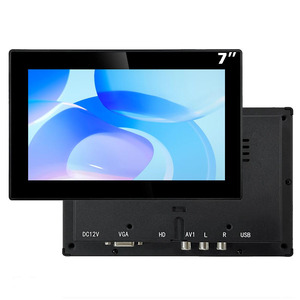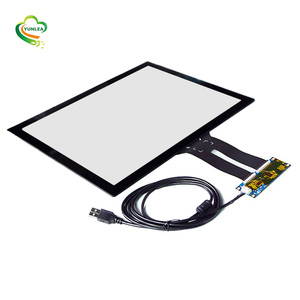(1091 products available)






























































































































































































































Users will find different types of waterproof touch screen Raspberry Pi models in the market. Each variant is designed to suit particular needs, preferences, and functionalities.
IP65 / IP66 Touch Screens:
The IP rating denotes the degree to which the device is protected against the entry of dust particles or water. IP65 and IP66 screens are built to resist low to high-pressure water jets, respectively. They can handle water exposure when cleaning or during rain. These screens have gaskets/ seals that prevent water entry into the inner components. Moreover, the waterproof touch screens are subjected to stringent testing and certified against water damage.
IP65 touch screens are suitable for industrial settings, machine consoles, self-service kiosks, HMIs, etc. Users can employ devices with IP66 ratings in environments with high water exposure, such as onsite construction, marine applications, etc.
Waterproof Enclosures:
They are cases that encase and protect touch screens from water damage. Waterproof enclosures come in various shapes and sizes. They can completely close the touch screen, leaving only the accessible glass part exposed. The protective cases have gaskets that seal any openings. They also have cable entry/ explosion-proof glands sealed to prevent water from passing through. The waterproof enclosures undergo rigorous testing to certify their watertight integrity. Waterproof enclosures are suitable for outdoor applications, industrial settings, and marine operations.
Ultra-rugged Touch Screens:
These waterproof touch screens are made for extreme applications. They can resist the entry of water and damage from shock, vibration, electrostatic discharge, temperature extremes, and other harsh conditions. The ultra-rugged waterproof touch screens come with IP67 to IP69K ratings. They have toughened glass displays that can withstand impacts and scratches in extreme work settings. Use ultra-rugged touch screens in heavy industrial applications, military operations, etc.
Custom Waterproof Screens:
Depending on design specifications, custom waterproof touch screens can be personalized to suit specific needs. They can come in various types and have distinctive features. Users can select the screen size, material, optical bonding, touchscreen technology (Projected Capacitive, Resistive), and level of brightness. Manufacturers will work with users throughout the process to ensure that all requirements are met and the final product is tested for quality and waterproof standards.
Waterproofing:
Waterproof touch screen Raspberry Pis are built with industry-standard IP ratings, like IP65 and IP68, which range from dust-proof only, to fully submersible in water. The rating indicates the level of protection against water and the dust entry in the device. For instance, a Raspberry Pi 4 touch screen with an IP68 rating can endure water exposure up to 1.5 meters for nearly 30 minutes. Waterproof touch screens with a minimum of IP65 can be washed with a steady stream of water without suffering damage. If the device will be used outdoors or in wet environments, then a higher IP-rated touch screen will be ideal.
Anti-fogging:
High humidity or water vapors can cause the screen to fog up, making it difficult to operate or read. Anti-fog screens have special coatings that prevent condensation from forming on the touch screen. This allows users to see the display clearly even in highly humid or steamy environments.
Modular design:
A modular design makes it easy to replace damaged or worn-out components in the touch screen without replacing the entire unit. Users can quickly and easily swap out parts to keep the touch screen in good working condition. This also reduces electronic waste by allowing users to only replace the part that is not functioning well.
HE glove compatibility:
Highly sensitive gloves (HE gloves) compatible touch screens allow users to operate the screen with various types of gloves on. This feature is ideal for outdoor or industrial environments where users have to wear gloves for safety or to protect against the elements. In cases where users need to operate the waterproof touch screen Raspberry Pi with ungloved hands, then it can still work because the screen is capable of discerning between the two.
Ambient light sensors:
Ambient light sensors detect the surrounding light levels and automatically adjust the brightness and contrast of the touch screen for optimal viewing. This improves visibility in various lighting conditions while also conserving energy.
Glare resistance:
Raspberry Pi waterproof touch screens with glare-resistant features have anti-glare coating or a matte finish that reduces reflectance. This improves visibility in outdoor or brightly lit environments, where screen glare can be a major challenge.
Rabbit proof:
Rabbit-proof touch screens are protected with heavy-duty mesh or screen that prevents curious rabbits or other animals from damaging the screen. In farms or pet houses where rabbits and other animals are allowed to roam freely, this touch screen will come in handy. The screens can also be used in areas with high animal traffic.
A waterproof touch screen Raspberry Pi has many applications, from home automation to educational projects. Here are some uses of a Raspberry Pi with a waterproof touch screen:
Home Automation
A waterproof touch screen can be placed in a strategic location, such as by the front door or in the kitchen. It can serve as a controller for smart home devices that allow the homeowner to adjust the thermostat, turn on lights, or check security cameras.
Hydroponics Systems
Raspberry Pi waterproof screens are useful in hydroponics systems management. They can be installed in the irrigation systems, where they monitor and control parameters such as pH levels, nutrient concentrations, and water temperature. Farmers can also access live data and adjust settings using the touch screen.
Marine Displays
A waterproof touch screen Raspberry Pi can be transformed into a navigation system for boats and other water vessels. The system can include GPS positioning, chart plotting, and instrumentation display. Users can also use the screen to check weather conditions and monitor routes to avoid potential hazards.
Industrial Controls
In factories with exposure to moisture, a waterproof touch screen Raspberry Pi can be used to monitor machinery. Operators can check the status of different types of machines and even receive alerts in case of a possible malfunction.
Outdoor Kiosks
In many public areas, waterproof touch screen Raspberry Pi can be used to create outdoor information kiosks. They can display maps, local attractions, public transport info, and emergency procedures. The kiosks can also be installed in tourist hotspots, where they provide info about the area.
Weather Station
A waterproof touch screen can be integrated into a weather station. It can be used to monitor temperature, humidity, precipitation, and wind speed. With an internet connection, the station can provide local forecasts and alerts for severe weather conditions.
Medical Equipment
In places with exposure to moisture, such as healthcare facilities, a waterproof touch screen can be used to monitor patients. It can be attached to a patient’s bed to read and record the patient's heart rate and other vital signs. Doctors can access real-time data and make timely decisions.
Automotive Displays
Raspberry Pi screens can also be used for entertainment in cars, trucks, and other vehicles. A waterproof touch screen is an ideal solution, as it minimizes the risks associated with non-waterproof screens that may be exposed to spills or moisture. The touch screen can offer users GPS navigation and access to an online music library.
When picking a waterproof touch screen Raspberry Pi for business projects, consider these factors to find one that suits needs:
Q1: Can I use the waterproof touch screen Raspberry Pi in outdoor environments?
A1: Yes, you can. The touchscreens are designed to withstand exposure to the elements, making them suitable for outdoor use.
Q2: What level of protection do the touch screens provide against water and dust?
A2: The waterproof touch screen Raspberry Pi monitors come with varying levels of protection, typically specified by an IP (Ingress Protection) rating. This rating indicates the screen's resistance to water and dust.
Q3: How can I clean a waterproof touch screen?
A3: Cleaning waterproof touch screens is usually simple. Use a soft, lint-free cloth and a mild, non-abrasive cleaning solution. Avoid using harsh chemicals or abrasive materials that could damage the screen's protective layer.
Q4: Can the touch screens withstand direct sunlight exposure?
A4: Some waterproof touch screens are designed to be sunlight-readable, meaning they can withstand direct sunlight exposure while remaining visible. Check the manufacturer's specifications to determine if the screen is suitable for such conditions.
Q5: Are the waterproof touch screens compatible with all Raspberry Pi models?
A5: Although the Raspberry Pi waterproof screens can be used with various models, it is crucial to verify compatibility. This is to ensure proper functionality and fit of the screen onto the device. Users should check the specifications provided by the manufacturer to determine compatibility with their specific Raspberry Pi model.